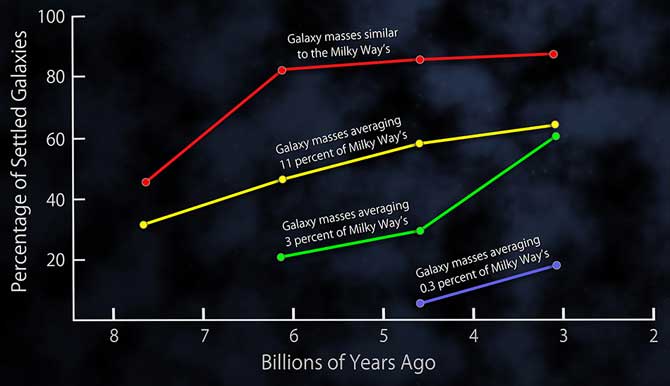Study reveals surprising pattern of galactic evolution

A surprising pattern of galactic evolution emerged in recent study by NASA astronomers. Contrary to their opinion that nearby galaxies had achieved their present state 8 billion years ago, observations suggest galaxies were changing steadily during this time period. They found that the most distant blue galaxies exhibit disorganized motions in multiple directions, much different from disk-shaped galaxies where rotation dominates over other internal motions, such as the Andromeda Galaxy or the Milky Way. Gradually, disorganized motions dissipate and rotation speeds increase, whereby galaxies settle into organized disks.
Susan Kassin, an astronomer at NASA’s Goddard Space Flight Center in Greenbelt, Md., and the study’s lead researcher said,
“Astronomers thought disk galaxies in the nearby universe had settled into their present form by about 8 billion years ago, with little additional development since. The trend we’ve observed instead shows the opposite, that galaxies were steadily changing over this time period.”
A study of 544 star-forming galaxies observed by the Keck and Hubble telescopes shows that disk galaxies like our own Milky Way unexpectedly reached their current state long after much of the universe’s star formation had ceased. Over the past 8 billion years, the galaxies lose chaotic motions and spin faster as they develop into settled disk galaxies. Credit: NASA’s Goddard Space Flight Center.
Blue colored galaxies where stars are forming, show less disorganized motions and ever-faster rotation speeds the closer they are observed to the present. This trend holds true for galaxies of all masses, but the most massive systems always show the highest level of organization. Researchers say the distant blue galaxies they studied are gradually transforming into rotating disk galaxies like our own Milky Way.

Co-author Benjamin Weiner, an astronomer at the University of Arizona in Tucson said,
“Previous studies removed galaxies that did not look like the well-ordered rotating disks now common in the universe today. By neglecting them, these studies examined only those rare galaxies in the distant universe that are well-behaved and concluded that galaxies didn’t change.”
Researchers extended the sample to all galaxies with emission lines bright enough to be used for determining internal motions. Emission lines are the discrete wavelengths of radiation characteristically emitted by the gas within a galaxy. On separation of galaxy’s light into its component colors they are revealed. These emission lines also carry information about the galaxy’s internal motions and distance.
The team studied a sample of 544 blue galaxies from the Deep Extragalactic Evolutionary Probe 2 (DEEP2) Redshift Survey, a project that employs Hubble and the twin 10-meter telescopes at the W. M. Keck Observatory in Hawaii. Located between 2 billion and 8 billion light-years away, the galaxies have stellar masses ranging from about 0.3 percent to 100 percent of the mass of our home galaxy. The Milky Way galaxy must have gone through the same rough-and-tumble evolution as the galaxies in the DEEP2 sample, and gradually settled into its present state as the sun and solar system were being formed.
Simulations such as this will help astronomers better understand the new findings in galaxy evolution. It tracks the development of a single disk galaxy from shortly after the Big Bang to the present day. Colors reveal old stars (red), young stars (white and bright blue) and the distribution of gas density (pale blue); the view is 300,000 light-years across. Credit: F. Governato and T. Quinn (Univ. of Washington), A. Brooks (Univ. of Wisconsin, Madison), and J. Wadsley (McMaster Univ.).
In the past 8 billion years, the number of mergers between galaxies large and small has decreased sharply. So has the overall rate of star formation and disruptions of supernova explosions associated with star formation. Scientists speculate these factors may play a role in creating the evolutionary trend they observe. Now after finding see this pattern, astronomers can adjust computer simulations of galaxy evolution until these models are able to replicate the observed trend. This will guide scientists to the physical processes most responsible for it.
Source: NASA News
Featured Image source: NASA/JPL-Caltech
Artist’s concept of Milky way

Commenting rules and guidelines
We value the thoughts and opinions of our readers and welcome healthy discussions on our website. In order to maintain a respectful and positive community, we ask that all commenters follow these rules.